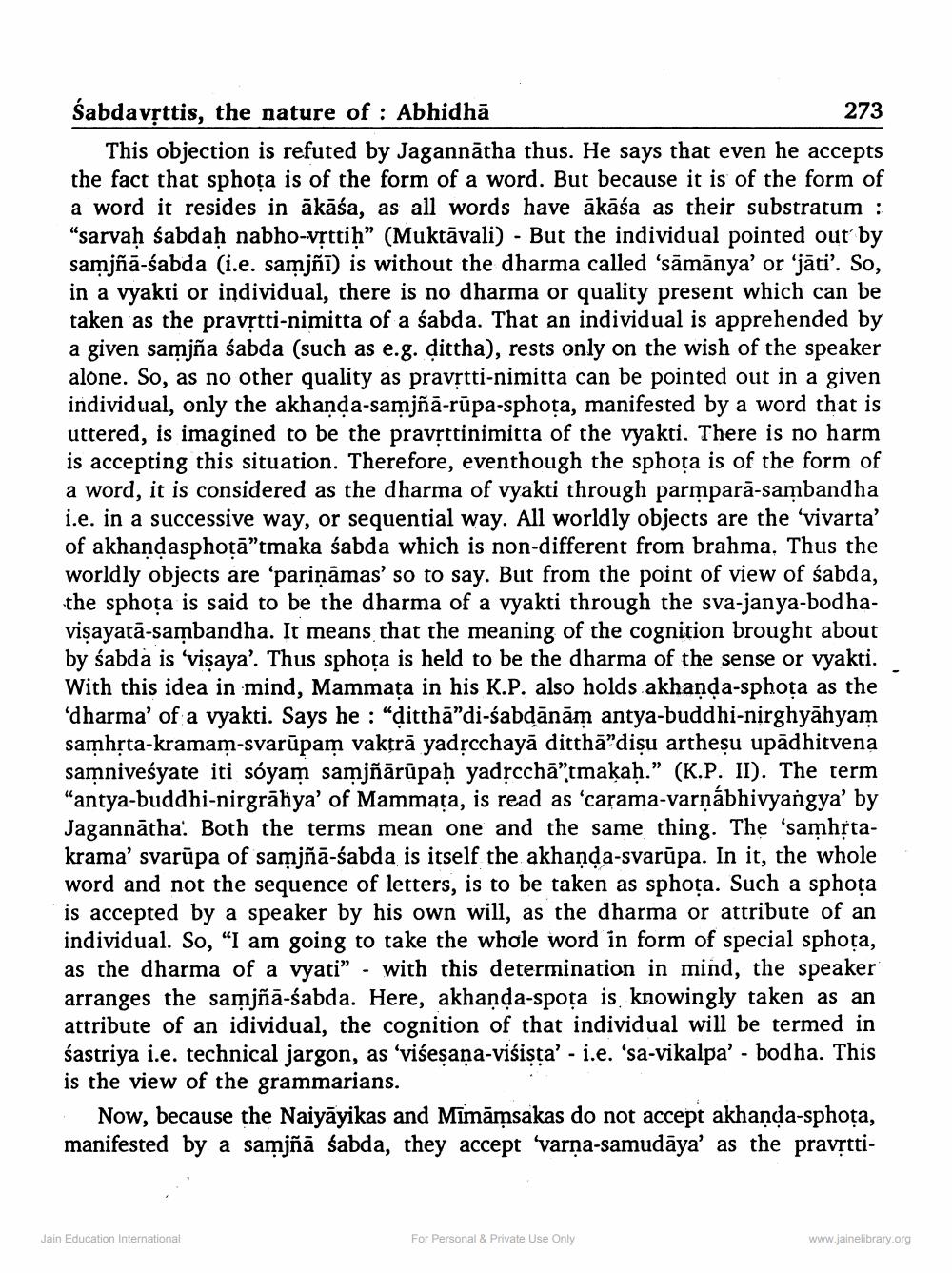________________
Sabdavrttis, the nature of : Abhidhā
273
This objection is refuted by Jagannātha thus. He says that even he accepts the fact that sphota is of the form of a word. But because it is of the form of a word it resides in ākāśa, as all words have ākāśa as their substratum : "sarvaḥ śabdaḥ nabho-vșttiḥ” (Muktāvali) - But the individual pointed out by samjñā-sabda (i.e. samjñi) is without the dharma called 'sāmānya' or 'jāti'. So, in a vyakti or individual, there is no dharma or quality present which can be taken as the pravrtti-nimitta of a śabda. That an individual is apprehended by a given samjña śabda (such as e.g. dittha), rests only on the wish of the speaker alone. So, as no other quality as pravstti-nimitta can be pointed out in a given individual, only the akhanda-samjñā-rūpa-sphoța, manifested by a word that is uttered, is imagined to be the pravsttinimitta of the vyakti. There is no harm is accepting this situation. Therefore, eventhough the sphoța is of the form of a word, it is considered as the dharma of vyakti through parmparā-sambandha i.e. in a successive way, or sequential way. All worldly objects are the 'vivarta' of akhandasphotā"tmaka sabda which is non-different from brahma. Thus the worldly objects are ‘pariņāmas' so to say. But from the point of view of sabda, the sphota is said to be the dharma of a vyakti through the sva-janya-bodhavişayatā-sambandha. It means that the meaning of the cognition brought about by śabda is 'visaya'. Thus sphota is held to be the dharma of the sense or vyakti. With this idea in mind, Mammata in his K.P. also holds akhanda-sphota as the dharma' of a vyakti. Says he : "ditthā”di-sabdānām antya-buddhi-nirghyāhyam samhsta-kramam-svarūpam vaktrā yadrcchayā ditthā"dişu arthesu upādhitvena samniveśyate iti sóyam samjñārūpah yadrcchā”tmakaḥ.” (K.P. II). The term "antya-buddhi-nirgrahya' of Mammata, is read as 'carama-varnabhivyangya' by Jagannātha. Both the terms mean one and the same thing. The 'samhţtakrama' svarūpa of samjñā-sabda is itself the akhanda-svarūpa. In it, the whole word and not the sequence of letters, is to be taken as sphoța. Such a sphoța is accepted by a speaker by his own will, as the dharma or attribute of an individual. So, "I am going to take the whole word in form of special sphoța, as the dharma of a vyati” - with this determination in mind, the speaker arranges the samjñā-sabda. Here, akhanda-spoța is knowingly taken as an attribute of an idividual, the cognition of that individual will be termed in śastriya i.e. technical jargon, as 'visesaņa-viśista' - i.e. 'sa-vikalpa' - bodha. This is the view of the grammarians.
Now, because the Naiyāyikas and Mimāmsakas do not accept akhanda-sphota, manifested by a samjñā sabda, they accept 'varna-samudāya' as the pravrtti
Jain Education International
For Personal & Private Use Only
www.jainelibrary.org




